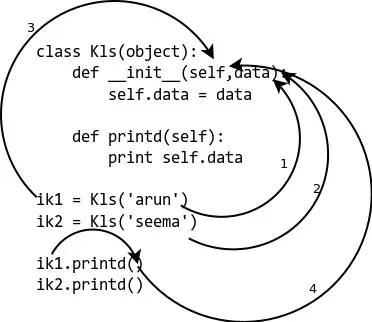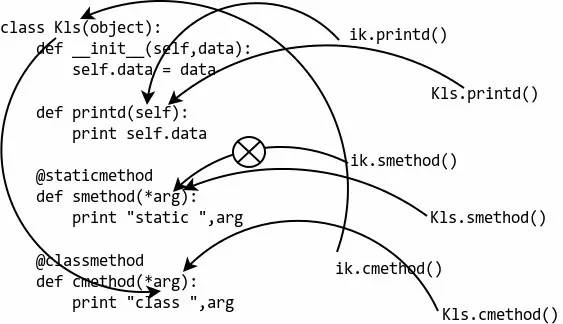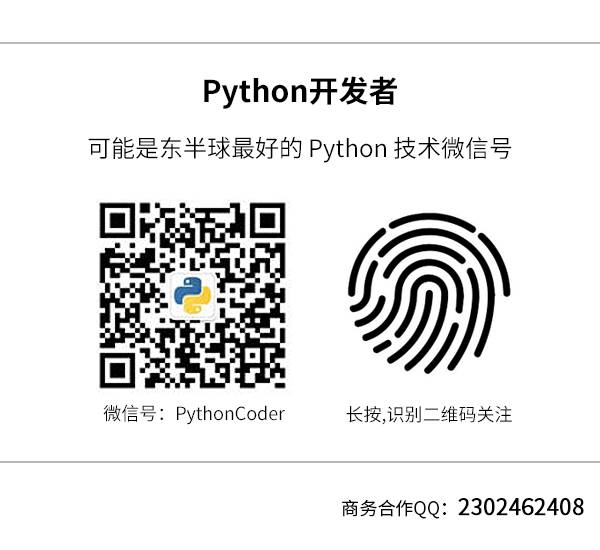Python中staticmethod和classmethod的差异
(点击上方公号,可快速关注)
英文:Arun Tigeraniya
作者:伯乐在线 - wklken
链接:http://python.jobbole.com/83584/
Class vs static methods in Python
这篇文章试图解释:什么是staticmethod/classmethod,并且这两者之间的差异.
staticmethod和classmethod均被作为装饰器,用作定义一个函数为”staticmethod”还是”classmethod”
如果想要了解Python装饰器的基础,可以看 这篇文章(http://www.pythoncentral.io/python-decorators-overview/)
Simple, static and class methods
类中最常用到的方法是 实例方法(instance methods), 即,实例对象作为第一个参数传递给函数
例如,下面是一个基本的实例方法
class Kls(object):
def __init__(self, data):
self.data = data
def printd(self):
print(self.data)
ik1 = Kls('arun')
ik2 = Kls('seema')
ik1.printd()
ik2.printd()
得到的输出:
arun
seema
调用关系图:

查看代码和图解:
1/2 参数传递给函数
3 self参数指向实例本身
4 我们不需要显式提供实例,解释器本身会处理
假如我们想仅实现类之间交互而不是通过实例?我们可以在类之外建立一个简单的函数来实现这个功能,但是将会使代码扩散到类之外,这个可能对未来代码维护带来问题。
例如:
def get_no_of_instances(cls_obj):
return cls_obj.no_inst
class Kls(object):
no_inst = 0
def __init__(self):
Kls.no_inst = Kls.no_inst + 1
ik1 = Kls()
ik2 = Kls()
print(get_no_of_instances(Kls))
结果:
2
The Python @classmethod
现在我们要做的是在类里创建一个函数,这个函数参数是类对象而不是实例对象.
在上面那个实现中,如果要实现不获取实例,需要修改如下:
def iget_no_of_instance(ins_obj):
return ins_obj.__class__.no_inst
class Kls(object):
no_inst = 0
def __init__(self):
Kls.no_inst = Kls.no_inst + 1
ik1 = Kls()
ik2 = Kls()
print iget_no_of_instance(ik1)
结果
2
可以使用Python2.2引入的新特性,使用@classmethod在类代码中创建一个函数
class Kls(object):
no_inst = 0
def __init__(self):
Kls.no_inst = Kls.no_inst + 1
@classmethod
def get_no_of_instance(cls_obj):
return cls_obj.no_inst
ik1 = Kls()
ik2 = Kls()
print ik1.get_no_of_instance()
print Kls.get_no_of_instance()
We get the following output:
2
2
The Python @staticmethod
通常,有很多情况下一些函数与类相关,但不需要任何类或实例变量就可以实现一些功能.
比如设置环境变量,修改另一个类的属性等等.这种情况下,我们也可以使用一个函数,一样会将代码扩散到类之外(难以维护)
下面是一个例子:
IND = 'ON'
def checkind():
return (IND == 'ON')
class Kls(object):
def __init__(self,data):
self.data = data
def do_reset(self):
if checkind():
print('Reset done for:', self.data)
def set_db(self):
if checkind():
self.db = 'new db connection'
print('DB connection made for:',self.data)
ik1 = Kls(12)
ik1.do_reset()
ik1.set_db()
结果:
Reset done for: 12
DB connection made for: 12
现在我们使用@staticmethod, 我们可以将所有代码放到类中
IND = 'ON'
class Kls(object):
def __init__(self, data):
self.data = data
@staticmethod
def checkind():
return (IND == 'ON')
def do_reset(self):
if self.checkind():
print('Reset done for:', self.data)
def set_db(self):
if self.checkind():
self.db = 'New db connection'
print('DB connection made for: ', self.data)
ik1 = Kls(12)
ik1.do_reset()
ik1.set_db()
得到的结果:
Reset done for: 12
DB connection made for: 12
How @staticmethod and @classmethod are different
class Kls(object):
def __init__(self, data):
self.data = data
def printd(self):
print(self.data)
@staticmethod
def smethod(*arg):
print('Static:', arg)
@classmethod
def cmethod(*arg):
print('Class:', arg)
调用
>>> ik = Kls(23)
>>> ik.printd()
23
>>> ik.smethod()
Static: ()
>>> ik.cmethod()
Class: (,)
>>> Kls.printd()
TypeError: unbound method printd() must be called with Kls instance as first argument (got nothing instead)
>>> Kls.smethod()
Static: ()
>>> Kls.cmethod()
Class: (,)
图解

【今日微信公号推荐↓】


查看评论 回复
"Python中staticmethod和classmethod的差异"的相关文章
- 上一篇:那些诡异难调的Bug
- 下一篇:PYTHON正成为中国互联网+的核心技术驱动力

